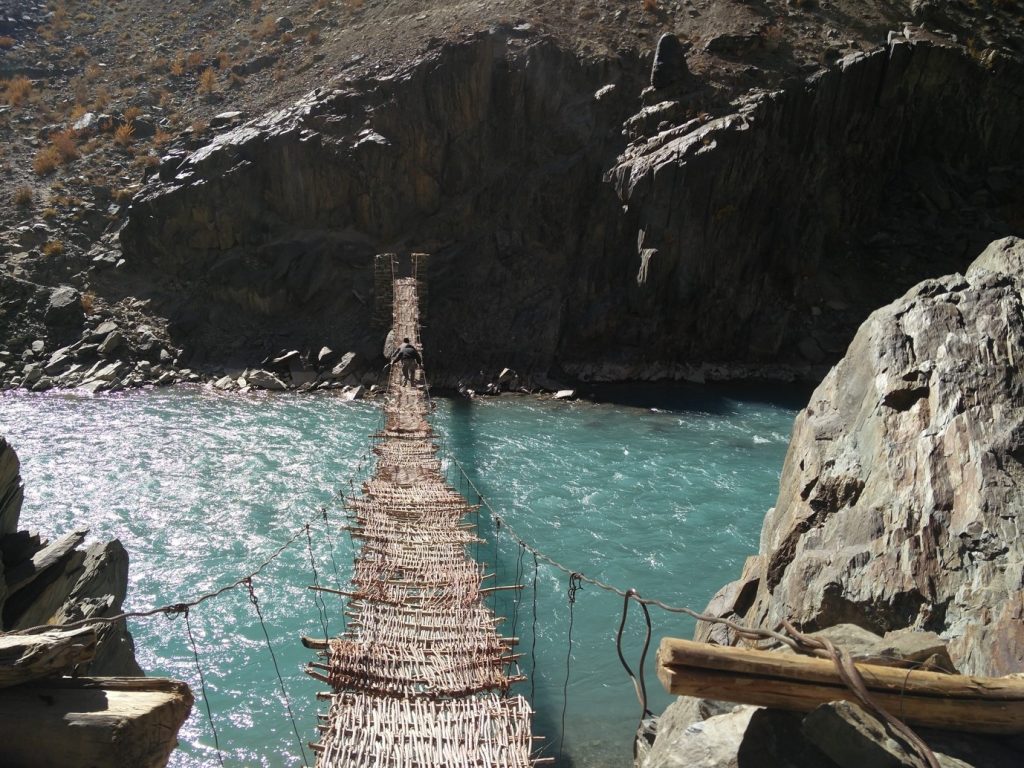
The Hanging Lifeline of Zanskar
Centuries-old hanging wooden bridges connect the most remote villages of Ladakh’s Zanskar Valley – but only 5 remain to this day
Story by: Shakeer Hussain
Hear an audio snippet
I still remember that evening. My friend Stanzin and I had to cross the Tsetaan wooden bridge to reach Marling, the oldest hamlet of the Lungnak Valley of Zanskar, for an electrification project. It was already dark, and before us lay probably the longest wooden bridge of Zanskar, precariously hanging above the gushing Tsarap River!
By the time we reached the middle, it was nearly 10 pm. All we could hear were sounds of the water flowing swiftly and the wind lashing. Darkness fell all around us. The bridge had a lot of cracks, and the other side seemed too far away. Stanzin began panicking, thinking the bridge might be breaking! Eventually we turned back towards the starting point to wait for sunlight. We spent the entire night outdoors, trying to survive without a roof or food.
The next morning, we walked across the bridge, reached the village and slept for the entire day!

These hanging bridges are the lifeline of Zanskar. Since there are no big willows in Ladakh, the people of Zanskar built these indigenous structures by putting together small twigs and shrubs in a dense formation. They were made in the olden times, with no modern architectural techniques, but the bridges serve the villages well. Each one can last for decades, with villages on both sides of the river contributing to the maintenance effort every 3-4 years. These are human-only bridges though (no horses). At one time, not more than two people (80-90 kgs) can cross the bridge.
In 2015, in the Lungnak valley of Zanskar, the landslides and floods washed away all bridges except one. Now that wooden bridge, also above Tsarap River (which finally becomes Zanskar River), is the only lifeline that connects the grand old monastery of Phugtal with the village of Yougar on the other side. During the electrification of the monastery, I remember the tremendous effort made by the villagers and monks to get the solar panels and batteries transported across the bridge – perhaps the most risky in Zanskar due to its height – and to the top of the hill.

The most remote monastery and village in Zanskar now run entirely on their own solar power grid – only because the old hanging bridge made it possible to transfer materials across the roaring river!
Things are changing quickly though. Roads are coming to the valley, and slowly the old hanging wooden bridges are being replaced by motorable ones. Only five hanging wooden bridges remain in Zanskar now, all of them in the Lungnak Valley.

The hanging wooden bridges might be old and shaky, and scary after dark, but they always make for interesting memories for locals and outsiders alike. They are usable throughout the harsh winter, but interestingly no one uses them. The Tsarap river freezes over in winter and people do not need bridges to commute. They simply walk on the frozen river to get from one village to another.
Hear an audio snippet of this story
Meet the storyteller








Ja, es kostet erstmal Überwindung über so eine Brücke zu gehen.
Aber es geschafft zu haben, seine anfängliche Angst zu besiegen ist ein tolles Gefühl, welches man nicht mehr vergisst.
That must have been one adventurous crossing, yet a memorable one.
Technology does take away the beauty of hand-made structures. Hoping atleast these bridges survive the wrath of technology.